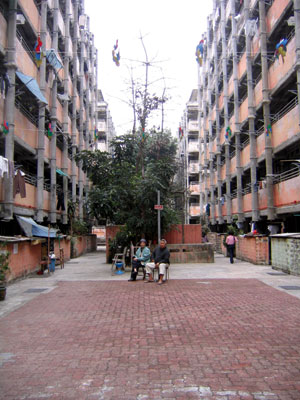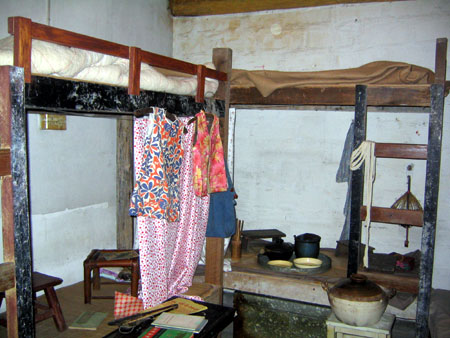Our Community
Related Stories

The 7-storey tall buildings have no lift, residents have to climb up and downstairs everyday. Shermaine Ho
Shek Kip Mei Estate
Taste the 60s and 70s in the old housing
By Shermaine Ho
Glittering skyscrapers, modern complexes, and the heady rush of huge financial deals are the images Hong Kong projects to the world.
Across the harbor, where lies the sharp contrast: the smell of diesel and garbage hangs in the air, the streets are dark and narrow, bare tungsten bulbs sway in a small breeze, kerosene tanks nestle below a small stove in a crowded kitchen, greasy woks and water bottles hang by a battered plywood wall. This is a 120-square foot ramshackle flat at Shek Kip Mei Estate.
The famous ¡§H¡¨ block Shek Kip Mei Estate is the first public housing estate in Hong Kong . It was built as an emergency response to the disastrous fire, which broke out in Shek Kip Mei on Christmas Eve in 1953.
To overcome the pressing need for resettlement; the estate was built with a functionalistic approach. The simplest structure was used with no decoration to maximize the utilization of space.
¡§Two to three families were huddled in these ¡¥little cages'. There were 8 people in my family, and we shared this flat with another family of 9 people,¡¨ said Wong Kan , an 84-year-old resident.
According to Mr. Wong, the living condition was extremely bad at that time. Private spaces were very limited, and people of the same floor had to share the same toilet, bathroom and kitchen. ¡§It was extremely crowded, and the hygiene was poor too,¡¨ he added.
Besides, basic facilities were also insufficient. There were water restrictions all the time, and electricity supply was unreliable. ¡§Usually, we had to take our buckets and queue up for water once every couple of days,¡¨ he said. ¡§That's why we treasure water a lot!¡¨
Although Mr. Wong said that the living conditions in the past were far from satisfactory, he believed the construction of the Shek Kip Mei Estate was already a big leap forward.
¡§Before the fire broke out, we lived in log cabins and squatters that were made of wood and iron plates. They were dangerous and vulnerable,¡¨ he said.
¡§These 7-floor buildings were a remarkable breakthrough. Though they are still small and crowded, they are safer and less vulnerable. At least, they were made of stone and cement,¡¨ he explained.
Mrs. Law Li Shau Kui, a 78-year-old woman said, ¡§I've been living here for 44 years, and I've witnessed how people and things have changed over time.¡¨
Due to the rapid development of the economy and the changes in the housing policy, such as the rich domicile policy and the cancellation of the heredity policy, the youth generation was encouraged to move out of the public estates. As a result, the old public housing estates have become ¡¥elderly estates' with lots of single elderly now.
Mrs. Law said, ¡§People became richer as a result of the on-going industrial development in the 1980s. They demanded higher standards of living, and so they gradually moved out of the estate, especially the younger generation,¡¨ she explained.
¡§In the past, we used to have 6 to 8 people sharing the same plank bed, but since my children have moved out, it became more spacious and the environment has become a bit better to live,¡¨ she said.
According to Ms. Li, a social worker of the Neighborhood Advice-Action Council, the government has been redeveloping the old estate and surrounding area.
¡§Old buildings were knocked down, failed slopes nearby were checked and repaired, and new estates were built for re-housing,¡¨ she said. ¡§The first and the second phrases of the clearance project were over, and the remaining 15 blocks would be cleared soon.¡¨
Ms. Li elaborated that the residents who are still living at the Shek Kip Mei Estate now are mostly old people and new immigrants from Mainland China .
¡§There are approximately 1400 residents in total, and 500 of them are old people who are over 65 years old,¡¨ she said. ¡§That's why aging is such a serious and difficult problem in Sham Shui Po.¡¨
Jacky Poon, a Year 2 social work student studying at the City University of Hong Kong said, ¡§I am currently doing internship at the Sham Shui Po District Council, and it's up till now that I really understand how challenging the aging problem is.¡¨
Apart from regular visits, talks, workshops and body check services, Jacky said it is equally important to help the elderly to voice their concerns and help them fight for more rights.
¡§The estate will be cleared soon, and so there's a pressing need for re-housing subsidies,¡¨ he explained. ¡§However, what these old people need most is not only money, but care and understanding.
¡§These old people have been living here for generations and they will miss here a lot,¡¨ he said. ¡§They know it is inevitable that these buildings will soon be cleared, but they also want others to know more about them and recognize the value of this old estate.¡¨
Mr. Kwan, a 79-year-old man who used to live in the estate said, ¡§I came here to visit my friend today. I just moved to Tin Shui Wai in November, but I miss my old home already.
¡§I'd been living in here for 30 years, and the memories are still fresh. The fire, the crowdedness, the water restrictions and electricity cut. Life wasn't easy back then, but it was happy,¡¨ he recalled.
Ms. Li said, ¡§For these old residents, the Shek Kip Mei Estate is where they have their memories. Although the estate is only 50 years old, it is a milestone in the history of Hong Kong .¡¨
The Neighborhood Advice-Action Council, the Sham Shui Po District Council, the Hong Kong Polytechnic University, and the Housing Authority are currently co-organizing an exhibition called the ¡§Shek Kip Mei People's Museum¡¨. Some blocks of the Estate are preserved and are open for public visits.
Ms. Li explained, ¡§On the one hand, we want the younger generation to know more about their origins and the history of Hong Kong ; on the other, we want to provide a place where the old people can meet and share their stories and experience. Experience and images surely speak more than words. The village is just like a live history book.¡¨
Old Mr. Wong said, ¡§I understand that the Shek Kip Mei Estate is old and demolished, and it's inevitable that it should be cleared for redevelopment, but I also want people to recognize it as a significant historical icon. It's part of our collective memories.¡¨
Candy, a 13-year-old secondary school student visiting the exhibition, said ¡§I used to feel extremely uncomfortable at my granny's home. It's dirty, smelly and small. But now I have a better understanding of their situation.¡¨
Jim, a primary school student also visiting the exhibition said, ¡§There are lots of buckets in my granny's home, and they are of different sizes. I once thought that it was a stupid idea, but now I know it's because of their old habits. I just can't imagine queuing up for water once every couple of days. It must be so troublesome!¡¨
Ms. Lam, a primary school teacher teaching in Kowloon Tong, was taking her class to the museum on that day. ¡§ Hong Kong is such an affluent city that children nowadays often take everything for granted. They don't know how to treasure things because they believe if you have money, you can do anything,¡¨ she elaborated.
¡§I wouldn't say Hong Kong parents have spoiled their kids, but it's definitely true that children in Hong Kong are too well-protected,¡¨ she said. ¡§They are just like the little buds and flowers in the greenhouse, far from attacks and shocks, and that's why they don't know how to appreciate and treasure things around them.¡¨
¡§It's so great that these kids have the chance to witness our living environment vividly. It's part of Hong Kong 's history, and they should be part of it too,¡¨ old Mr. Wong said.
